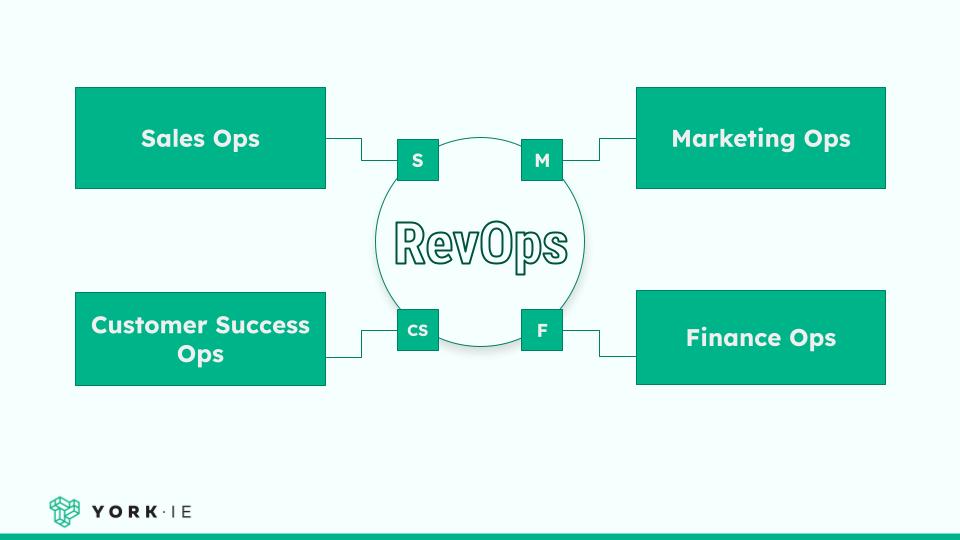By Craig Handy and Sebastian Silva
Revenue operations (RevOps) enables a buyer-centric go-to-market approach that drives revenue more quickly, efficiently and predictably by unifying people, processes, technology and data.
Revenue operations professionals act as buyers’ advocates in B2B organizations and help align internal processes with the buyers’ journey. RevOps roles have become more common in medium-size and large businesses since the 2010s, but there is also a need among startups and smaller companies.
RevOps is proven to improve sales success and increase revenue; of companies that use revenue operations and intelligence, 59% reported higher win rates and 53% saw increased net-dollar retention, according to Forrester.
Table of Contents
- What Does Revenue Operations Do?
- RevOps vs. Sales and Marketing Ops
- Core RevOps Tools
- Benefits of Revenue Operations
What Does Revenue Operations Do?
The objective of RevOps is to drive revenue for the business. The way that we do that, first and foremost, is by being buyers’ advocates throughout the entire go-to-market (GTM) process — from lead generation all the way to a successful sale, renewal or upsell.
RevOps professionals are responsible for unifying their organizations’ people, processes, technology and data to ensure buyer-centricity throughout that journey. They’re asking questions such as:
- What people are involved?
- What technologies do we need?
- Is our current tech driving us forward or holding us back?
- Do our processes make sense, or are they broken?
The answers to these questions should all be guided by what we like to call the three Rs of RevOps:
- right person
- right time
- right way
These principles are crucial, both internally and externally. Internally, they mean that the right person from your company is doing the right thing at the right time to actually generate revenue and drive the business forward. Externally, they mean that you’re speaking to the right person at your customer or prospect, at the right time for their business, in the way that works best for them.
RevOps vs. Sales Ops and Marketing Ops
Explaining what revenue operations is not can help explain more about what it actually is. RevOps is not:
- sales operations;
- customer success operations,
- marketing operations; or
- finance operations.

Now, there are a lot of elements of those specific ops functions that can be part of RevOps, and oftentimes RevOps people are well-versed in those topics. But RevOps is very much focused on the entire buyers’ journey and the entire revenue process, whereas you traditionally see sales ops and customer success ops roles focus more internally. For example, sales ops is going to be really focused on things like commissions.
There are, however, a lot of similarities between marketing ops and RevOps. Marketing ops is the operational arm that actually designs and executes how you communicate with your customers from a strategic perspective, and RevOps often does that as well.
Core RevOps Tools
Key revenue operations technologies include:
- customer relationship management (CRM) systems;
- marketing automation platforms; and
- revenue engagement tools.
CRM, marketing automation and revenue engagement play important roles in GTM, but they can easily bog down businesses that don’t have the expertise to use them properly. RevOps takes away this stress from sales, marketing and customer success teams so they can focus on their areas of strength.
Benefits of Revenue Operations
RevOps can help businesses:
- reduce technical debt;
- increase revenue and decrease costs; and
- improve internal processes.
Reduce Technical Debt
A question we get asked a lot is, “When should my company start thinking about RevOps?” Our first answer is, yesterday. Our second answer is, right now.
Businesses naturally acquire technology before acquiring the people with the expertise to fully take advantage of it. This is perfectly normal, but things can start to go wrong when there’s no plan in place to either hire those people eventually or engage with a company who can help advise and manage that tech.
When you don’t take the time to design your key systems with a clear vision on how they will be used by their teams, or what data they will need to store, or how to surface that data properly, it ends up leading to poor execution. This can have a compounding effect and increase your technical debt over time.
Increase Revenue and Decrease Costs
Going back to our earlier point about buyer-centricity, one of the ways that we often illustrate that is by saying this: You don’t want to be shipping your org chart.
What that means is, your buyer doesn’t care who the director is, or whose territory it is, or what the lead is attributed to. What they care about is that you’re able to solve their problem or give them an opportunity to generate more revenue or drive more growth.
RevOps enables businesses to start making decisions that orient themselves around meeting buyers’ needs, solving buyers’ problems and creating a smooth, logical journey for them to go through from start to finish. And when you do that, you not only directly contribute to increased revenue, but you also increase the odds that you’re not going to overspend on poor leads.
Improve Internal Processes
Sales stages are not a to-do list, although we see a lot of organizations treat them this way. Send documents, send follow-up, update field. Those stages don’t matter to the buyer. What matters is what they’re going through.
When you align your GTM processes with what the buyer is thinking, you can create sales stages that provide value throughout the journey. And this value is compounding, for both the buyer and for you.
Every time you get a little bit further in that process, you’re learning something. You’re learning that buyers of your product resonate with X, or they don’t resonate with Y. And as you learn more and more, you get really good at aligning yourself with what that particular buyer experience is, and that’s what really starts to drive things forward.
To learn more about what revenue operations is, watch our video on Fuel.






